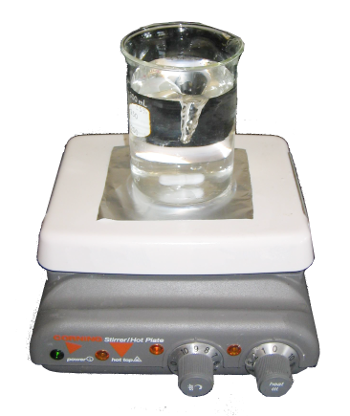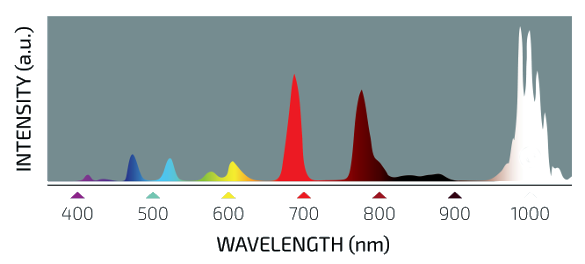Wave Mixing
August 20, 2018
One
social construct of my
undergraduate days was the
college "mixer" in which
male and
female students would interact socially. This was an
innocent time before people could
swipe left and right, and when
hookups were a
perversion rather than a
recreation. A college mixer was a place at which a
scientist could meet non-scientists and attempt to discover why someone would spend his/her life
randomly splashing paint onto
canvas.[1]
Mixed drinks and
radio mixing boards were likewise a part of my youth, but the more important mixing was
scientific and
technical. As a
novice chemist I learned the difference between a
mixture of substances and the
reaction product of substances that is a
chemical compound. I also made use of a common
laboratory mixer, the
hot plate with integral
magnetic stirrer.

Laboratory hot plate with magnetic stirrer.
The boiling points of aqueous solutions are near the boiling point of water, 100 °C.
The Curie temperature of the most common bar magnet
bar magnet, Alnico 5, is above 500 °C, so the stirring magnet is largely unaffected by the temperature.
(Wikimedia Commons image by Ruhrfisch.)
One mixer employed in
electrical engineering is the
frequency mixer, an
electronic circuit that combines two
frequencies to produce the
sum and
difference of these frequencies. This process is magically done by a
nonlinear circuit element, such as a
diode. This magic, exposed to be a simple
trick by
mathematical analysis (shown
here), enables
superheterodyne receivers by mixing a local
oscillator with a
radio signal to produce a more easily
amplified and
detected intermediate frequency.
One frequency mixer that I've used often to bring high frequency signals into an easily measurable range is a
digital mixer created with a
D-type flip-flop. The two
square wave inputs
F1 and
F2 to this circuit produce an output
ΔF that's the difference of
F1 and
F2 when these frequencies are within 50% of each other. It will even give a difference related to
harmonics of
F1, giving a
modulus output (
F2 mod F1).

Digital mixer circuit. Left, the usual abstract representation of a signal mixer. Middle, a realization of a digital mixer using logic gates to create a D-type flip-flop. In a D-type flip flop, the output, Q, gets the value of D on the leading-edge (low-to-high) transition of the square wave input at CLK. Right, a practical implementation of a digital mixer using half of a CD4013 integrated circuit. (Created using Inkscape. Click for larger image.)
Signal mixing isn't limited to radio frequency signals. At lower frequency,
audio signals at
high intensity, about the
sound level of a home
belt sander or a
hand-held electric drill, will produce a non-linear response in the
human ear.[2]
At much higher frequency, a
non-linear optical material, such as
lithium niobate, will allow
four-wave mixing in which high intensity light from three
lasers at different frequencies will produce light at multiple frequencies. The process is most
efficient when there is
phase matching of the optical signals, which is generally achieved by selecting certain
propagation directions in the non-linear
crystal.
If the frequencies of the three light signals are
f1,
f2, and
f3, the resulting frequencies produced will be
f1 ± f2 ± f3
In the end, you'll have twelve different
wavelengths of light, three of which are the starting laser signals.
I've had
optical physics colleagues who worked on four-wave mixing, and it's one of those topic area in which the
devil is in the details; specifically the phase matching and the available optical crystals. To transcend these problems, a team of
physicists from
Sandia National Laboratories (Albuquerque, New Mexico) and the
Friedrich Schiller University Jena (Jena, Germany) has accomplished such
frequency synthesis with a
gallium arsenide-based
dielectric metamaterial. Their results are published in an
open access paper in
Nature Communications.[3-4].
Phase-matching of the
fundamental and generated light frequencies is needed when using non-linear optical crystals for frequency synthesis since the nonlinear optical processes are weak.[3] Gallium arsenide has large
nonlinear susceptibility coefficients, and it has low
optical loss below the
bandgap, but it can't be used since it's a
dispersive material.[3] That's why frequency synthesis is relegated to
birefringent materials such as
lithium niobate and
β-barium borate that have much smaller nonlinear susceptibility.[3] A technique called
quasi-phase matching can be used for other materials, but it will function over just a small range of frequencies.[3]
Metamaterials consist of
nanoscale repeating structures of dimension smaller than a wavelength, and these interact with
electromagnetic waves such a light differently than conventional materials.[4] The research team fabricated a gallium arsenide metasurface as an array of
cylinders about 500
nanometers tall with a
diameter of about 400 nanometers spaced about 840 nanometers apart from each another.[4] The laser
infrared wavelengths
f1 and
f2 mixed to create eleven color frequencies that included
f1 +
f1,
f1 +
f2,
f2 +
f2,
f1 +
f1 +
f2, and
f1 +
f2 +
f2.[3-4]

Illustration of the light output of the Sandia National Laboratories metamaterial optical mixer. The infrared light intensity is about ten times stronger than that of the red light. (Sandia Labs image by Michael Vittitow, modified)[4]
At this time, the
conversion efficiency of this unique optical metamixer is low, but the efficiency might be improved by stacking multiple layers of metamaterial.[4] The optical mixing was only obtained through use of
femtosecond lasers that produce short, but powerful, light
pulses.[4] Says Sandia
physicist and paper
author,
Polina Vabishchevich,
"With this tiny device and two laser pulses we were able to generate 11 new colors at the same time, which is so cool... We don't need to change angles or match phases."[4]
There may be some applications for such a plethora of wavelengths in
fiberoptic communication,
atmospheric research,
remote sensing, and
quantum optics.[4] This process would be useful in the creation of intense laser light at wavelengths not generated by today's lasers.[4] This research was
funded by the
US Department of Energy's Office of Science.[4]
References:
- There was apparently a method to Jackson Pollock's madness, but the geometer in me prefers the cubist works of Georges Braque.
- J.R.M. Aerts and J.J.J.Dirckx, "Nonlinearity in eardrum vibration as a function of frequency and sound pressure, Hearing Research, vol. 263, no. 1-2 (May, 2010), pp. 26-32, https://doi.org/10.1016/j.heares.2009.12.022.
- Sheng Liu, Polina P. Vabishchevich, Aleksandr Vaskin, John L. Reno, Gordon A. Keeler, Michael B. Sinclair, Isabelle Staude, and Igal Brener, "An all-dielectric metasurface as a broadband optical frequency mixer," Nature Communications, vol. 9, Article no. 2507 (June 28, 2018). This is an open access publication with a PDF file available here.
- Sandia light mixer generates 11 colors simultaneously - First nanostructured material for broad mixing of light waves, Sandia Labs Press Release, June 28, 2018.
Linked Keywords: Sociology; social construct; undergraduate education; singles event; college "mixer"; male; female; student; innocence; innocent; Tinder (app); swipe left and right; hookup culture; hookup; perversion; recreation; scientist; randomness; random; splash (fluid mechanics); paint; oil painting; canvas; drink mixer; mixed drink; mixing console; radio mixing board; science; scientific; technology; technical; novice; chemist; mixing (process engineering); mixture of substances; reaction product of substances; chemical compound; laboratory; hot plate; magnetic stirrer; laboratory; boiling point; aqueous solution; properties of water; water; Curie temperature; bar magnet; Alnico 5; stirring magnet; temperature; Wikimedia Commons; Ruhrfisch; electrical engineering; frequency mixer; electronic circuit; frequency; frequencies; addition; sum; subtraction; difference; nonlinear system; electrical element; circuit element; diode; magic illusion; trick; mathematics; mathematical analysis; superheterodyne receiver; electronic oscillator; radio signal; amplifier; amplified; detector; detected; intermediate frequency; digital; gated D latch; D-type flip-flop; square wave; harmonic; modulo operation; modulus; digital mixer circuit; logic gate; CD4013 integrated circuit; Inkscape; audio signal; intensity; sound pressure; sound level; belt sander; hand-held electric drill; human ear; non-linear optical material; lithium niobate; four-wave mixing; laser; energy conversion efficiency; efficient; phase matching; Miller index; propagation direction; crystal; wavelength; optical physics; colleague; devil is in the details; physicist; Sandia National Laboratories (Albuquerque, New Mexico); Friedrich Schiller University Jena (Jena, Germany); frequency synthesis; gallium arsenide; dielectric; metamaterial; open access paper; Nature Communications; fundamental frequency; nonlinear susceptibility; coefficient; insertion loss; optical loss; bandgap; dispersion (optics); dispersive; birefringence; birefringent; β-barium borate; quasi-phase matching; nanoscopic scale; nanoscale; electromagnetic radiation; electromagnetic wave; cylinder; nanometer; diameter; infrared light; Michael Vittitow; femtosecond laser; pulse; author; Polina Vabishchevich; fiberoptic communication; atmosphere of Earth; atmospheric research; remote sensing; quantum optics; funding of science; funded; United States Department of Energy; Office of Science; Jackson Pollock; cubism; Georges Braque.